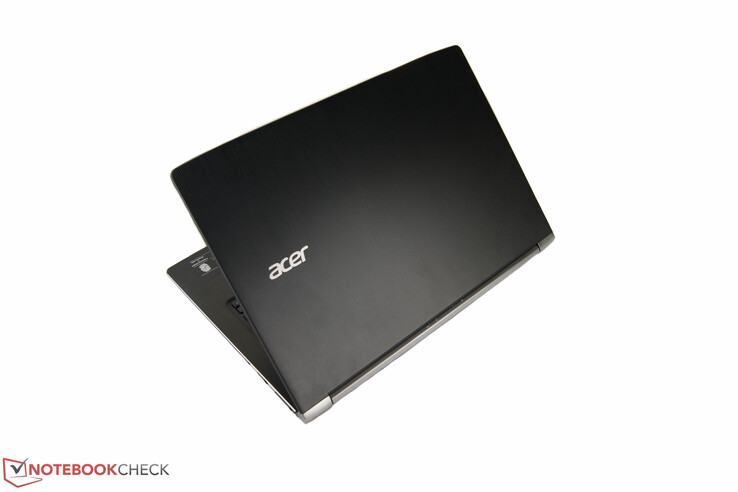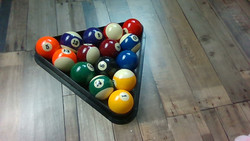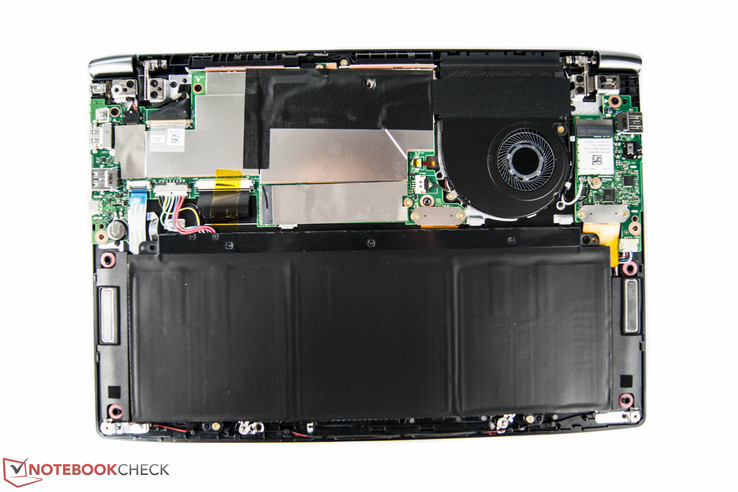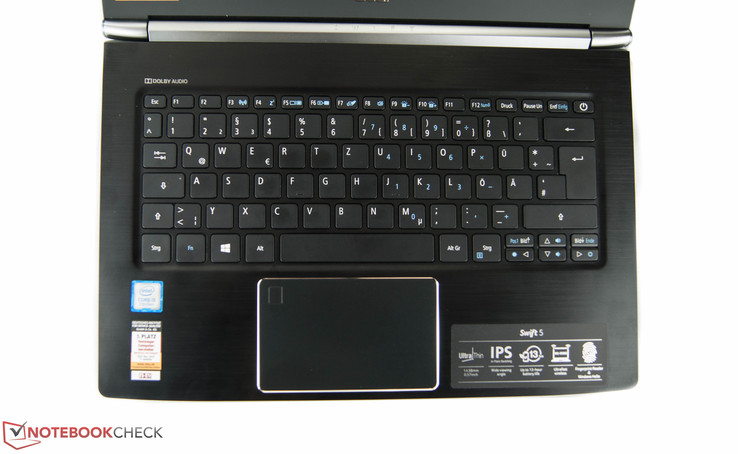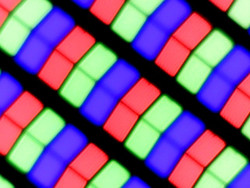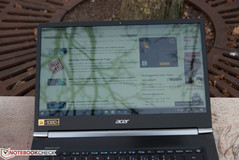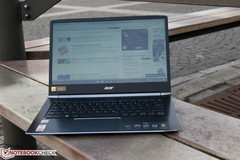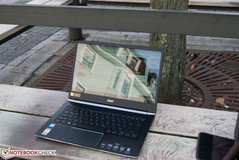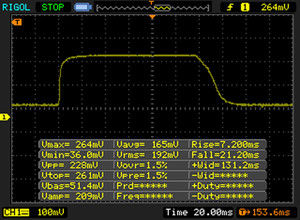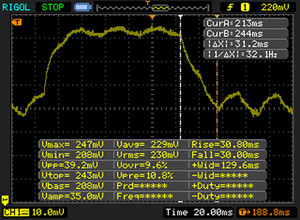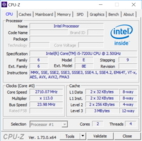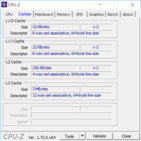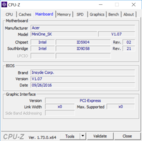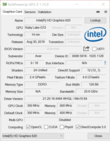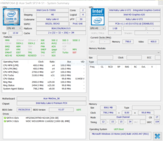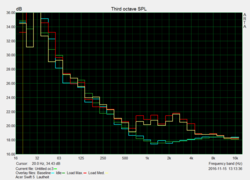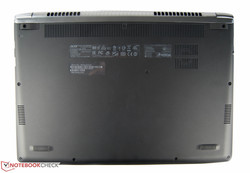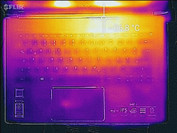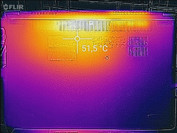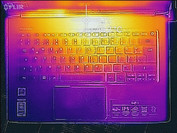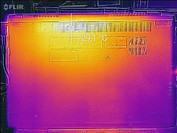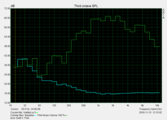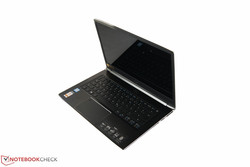Acer Swift 5 SF514-51-59AV Notebook Review

For the original German review, see here.
Another new device from the IFA 2016 is the Acer Swift 5. The new subnotebook is equipped with Intel's latest Kaby Lake generation and there are currently two SKUs. Our test model is equipped with an Intel Core i5-7200U, 8 GB DDR3 memory and a 256 GB SSD, which is currently available for 900 Euros (~$947). Another 100 Euros (~$107) will get you Intel's Core i7-7500U.
Over the course of this review, the test model has to compete with some rivals. We will use more subnotebooks with similar specifications: The Dell XPS 13 9360 and the Asus Zenbook 3, both of which got a "very good" score in our reviews. We also use the Medion Akoya S3409 as well as the Lenovo IdeaPad 510S equipped with the Intel Core i7-7500U.
Case
The first impression of the new Swift 5-series is that it is familiar, because the darker Obsidian design was first introduced with Acer's V-series. However, the design was limited to plastic components back then, while we now get a much more compact and sophisticated chassis. The Swift 5 is surrounded by metal elements that create a particularly elegant impression, and the lid is textured. Acer changed the looks of the base unit as well: A brushed aluminum finish, which looks nice, but also attracts fingerprints. One particularly impressive design decision is the display with small bezels, where we can only measure 8.3 mm (left and right bezel) as well as 10 mm (at the webcam).
The display hinge is not particularly taut, but you still need both hands to open the lid. The tactile feeling is very good thanks to many rounded edges and a very straightforward design. The bottom panel is also rubberized, which improves the grip, but there are no maintenance hatches and the battery cannot be accessed, either.
In short: The Swift 5 is a thin and very light subnotebook. We can only measure a height of 14.6 mm (~0.58 inches) and a weight of 1.35 kg (~3 pounds). For comparison: Lenovo IdeaPad 510S as well as the Medion Akoya S3409 are 150 grams (~0.33 lb) heavier and also a bit thicker. Dell's XPS 13 on the other hand is similarly slim, but 120 grams (~0.27 lb) lighter. The winner in this section is still the Asus Zenbook 3 at just 914 grams (~2 lb), and it is also 3 mm (~0.12 in) slimmer.
Connectivity
Slim subnotebooks usually have a limited port variety. The Swift 5 is equipped with HDMI as well as three USB ports, and the manufacturer fortunately waives the slow USB 2.0 standard.
All ports are located at the sides towards the rear, so attached cables are usually no problem at the desk or when you use an external mouse.
SD Card Reader
We use our reference memory card from Toshiba (Exceria Pro SDXC 64 GB UHS-II) to check the performance of the integrated SD-card reader. It manages 68.1 MB/s when we copy JPEG-files (~5 MB each), which is pretty average among our comparison group. Only the Dell XPS 13 is much better at 108 MB/s, while the Medion Akoya S3409 (16.5 MB/s) falls behind.
| SD Card Reader | |
| average JPG Copy Test (av. of 3 runs) | |
| Dell XPS 13 9360 FHD i5 | |
| Lenovo IdeaPad 510S-13IKB 80V00026GE | |
| Acer Swift 5 SF514-51-59AV | |
| Medion Akoya S3409-MD60234 | |
| maximum AS SSD Seq Read Test (1GB) | |
| Dell XPS 13 9360 FHD i5 | |
| Acer Swift 5 SF514-51-59AV | |
| Lenovo IdeaPad 510S-13IKB 80V00026GE | |
| Medion Akoya S3409-MD60234 | |
Communication
Network connections can be established via a WLAN module with the designation Qualcomm QCA6174. This 2x2 MIMO device manages a maximum transfer of 866 Mbps (gross). We check the real-world performance in our standardized WLAN test with iperf in a 5 GHz network. The result is an average client transfer rate of 659 Mbps (up to 690 Mbps) and 643 Mbps (up to 684 Mbps) as a server.
The Swift 5 also has a 720p webcam for video conferences, but the results are very poor, even under good lighting conditions. There is also a lot of picture noise when the environment gets darker. Colors and shapes are very distorted, and we can only hope future products will get better cameras.
| Networking | |
| iperf Server (receive) TCP 1 m | |
| Asus Zenbook 3 UX390UA-GS041T (jseb) | |
| Acer Swift 5 SF514-51-59AV (jseb) | |
| Medion Akoya S3409-MD60234 (jseb) | |
| Lenovo IdeaPad 510S-13IKB 80V00026GE | |
| iperf Client (transmit) TCP 1 m | |
| Acer Swift 5 SF514-51-59AV (jseb) | |
| Asus Zenbook 3 UX390UA-GS041T (jseb) | |
| Medion Akoya S3409-MD60234 (jseb) | |
| Lenovo IdeaPad 510S-13IKB 80V00026GE | |
Security
Consumers do not have to waive all security standards. Acer equips the Swift 5 with TPM, a Kensington Lock as well as a swipe-style fingerprint scanner in the touchpad. The latter works very well and is pretty quick when you use it for logins.
Accessories
Acer only ships the Swift 5 with a brochure and we cannot find dedicated accessories on the product website, either.
Maintenance
You will have to remove the whole bottom panel to access the components. This requires the loosening of ten visible screws, but the lifting of the panel itself requires patience and special tools. There are numerous plastic clips and you better have some experience. Acer allows users to clean the fan and replace both the SSD the WLAN module. Unfortunate: It is not possible to upgrade the memory.
Warranty
Not always a matter of course: Acer grants a standard warranty period of 24 months starting with the purchase. If you select the rival product from Dell, you only get a one-year warranty by default and can buy additional services. We have no exact warranty details for the Swift 5 yet, but it is usually a Pickup & Return service with an additional International Traveller's Warranty.
Please see our Guarantees, Return Policies & Warranties FAQ for country-specific information.
Input Devices
Keyboard
The Swift 5 is equipped with a black chiclet keyboard. It features a two-stage background illumination, so you can also use it comfortably in darker environments. All keys have a very comfortable pressure point, but the key travel could be longer. Another drawback is that the center area of the keyboard bounces a bit. 10-finger typists will have to get used to the limited travel at first, but even longer typing sessions should not be an issue. The small distance between some keys and their adjacent keys (like shift and return) also takes some time getting used to.
We want to praise the low noise development during typing. The typing noise is very muffled and quiet.
Touchpad
The mouse replacement is a touchpad of 10.5 x 6.5 centimeters (~4.1 x 2.6 in), which is surrounded by a chrome strip. Inputs are executed very quickly and precisely on the smooth surface, and multi-touch gestures are no problem for the test unit, either. Acer's new laptop can also convince in the corners, where we can sometimes notice problems on other touchpads. Only the swipe-style fingerprint scanner in the upper left corner of the touchpad is a bit unusual at first. The cursor movement will be stopped if your fingers cross this area.
There are two mouse buttons underneath the mouse replacement. The travel gets a bit longer towards the lower corners, although the resulting clicking sound is almost identical. One negative observation is that the whole keyboard unit is slightly depressed when we click.
Display
Acer equips the Swift 5 notebooks with glossy IPS displays, but no model will have a matte panel – contrary to the new Swift 3. Rivals like the Lenovo IdeaPad 510S and the Dell XPS 13 are alternatives if you do not want a glossy screen.
Dell and Medion also offer QHD+ panels for an additional charge. Acer stays pretty conventional with a Full HD screen. The display luminance is decent at 340 cd/m², but we can notice an uneven brightness distribution. The difference between the center and the lower right corner is 81 cd/m², for example. Backlight bleeding is no big problem and only slightly visible in the upper left corner.
The majority of the comparison devices manage very similar values for the luminance, but the brightness distribution is usually better at around 90%. Only the Lenovo IdeaPad is disappointing in terms of luminance (253 cd/m² on average).
| |||||||||||||||||||||||||
Brightness Distribution: 79 %
Center on Battery: 393 cd/m²
Contrast: 1355:1 (Black: 0.29 cd/m²)
ΔE ColorChecker Calman: 6.17 | ∀{0.5-29.43 Ø4.77}
ΔE Greyscale Calman: 6.8 | ∀{0.09-98 Ø5}
91% sRGB (Argyll 1.6.3 3D)
51% AdobeRGB 1998 (Argyll 1.6.3 3D)
64.3% AdobeRGB 1998 (Argyll 3D)
91.3% sRGB (Argyll 3D)
62.8% Display P3 (Argyll 3D)
Gamma: 2.27
CCT: 6873 K
| Acer Swift 5 SF514-51-59AV AU Optronics B140HAN3.2, , 1920x1080, 14" | Lenovo IdeaPad 510S-13IKB 80V00026GE LG Philips LP133WF2-SPL1, , 1920x1080, 13.3" | Medion Akoya S3409-MD60234 LG Philips LP133QD1-SPA3, , 3200x1800, 13.3" | Dell XPS 13 9360 FHD i5 Sharp SHP1449 LQ133M1, , 1920x1080, 13.3" | Asus Zenbook 3 UX390UA-GS041T AUO B125HAN03.0 AUO306D, , 1920x1080, 12.5" | |
|---|---|---|---|---|---|
| Display | -38% | -1% | -21% | 1% | |
| Display P3 Coverage (%) | 62.8 | 38.61 -39% | 64.6 3% | 48.94 -22% | 64.7 3% |
| sRGB Coverage (%) | 91.3 | 57.9 -37% | 87.3 -4% | 73.3 -20% | 89.6 -2% |
| AdobeRGB 1998 Coverage (%) | 64.3 | 39.92 -38% | 63.8 -1% | 50.5 -21% | 65.4 2% |
| Response Times | 19% | 22% | 9% | 24% | |
| Response Time Grey 50% / Grey 80% * (ms) | 51 ? | 39 ? 24% | 34 ? 33% | 32.8 ? 36% | 30 ? 41% |
| Response Time Black / White * (ms) | 28 ? | 24 ? 14% | 25 ? 11% | 33.2 ? -19% | 26 ? 7% |
| PWM Frequency (Hz) | 250 ? | 50 ? | |||
| Screen | -10% | -10% | 4% | 1% | |
| Brightness middle (cd/m²) | 393 | 259 -34% | 295 -25% | 351.2 -11% | 355 -10% |
| Brightness (cd/m²) | 338 | 253 -25% | 283 -16% | 325 -4% | 341 1% |
| Brightness Distribution (%) | 79 | 82 4% | 88 11% | 89 13% | 87 10% |
| Black Level * (cd/m²) | 0.29 | 0.33 -14% | 0.65 -124% | 0.195 33% | 0.3 -3% |
| Contrast (:1) | 1355 | 785 -42% | 454 -66% | 1801 33% | 1183 -13% |
| Colorchecker dE 2000 * | 6.17 | 5.12 17% | 4 35% | 7.4 -20% | 5.97 3% |
| Colorchecker dE 2000 max. * | 11.21 | 10.12 10% | 7.26 35% | 9.08 19% | 10.55 6% |
| Greyscale dE 2000 * | 6.8 | 3.8 44% | 3.38 50% | 6.71 1% | 6.45 5% |
| Gamma | 2.27 97% | 2.39 92% | 2.38 92% | 2.74 80% | 2.45 90% |
| CCT | 6873 95% | 7405 88% | 6520 100% | 7222 90% | 7694 84% |
| Color Space (Percent of AdobeRGB 1998) (%) | 51 | 37 -27% | 57 12% | 50.48 -1% | 58 14% |
| Color Space (Percent of sRGB) (%) | 91 | 58 -36% | 85 -7% | 73.31 -19% | 89 -2% |
| Total Average (Program / Settings) | -10% /
-12% | 4% /
-4% | -3% /
-0% | 9% /
4% |
* ... smaller is better
We can determine a good contrast ratio of 1355:1. Darker colors and black shades are sufficiently rich, which is particularly good for movies. Only the Dell XPS 13 manages an even higher contrast ratio at 1801:1.
The next item on our list is the CalMAN analysis. The deviations for the colors and the grayscale are only average, despite the IPS panel. A closer look at the grayscale reveals a slight green cast.
The color gamut, which is particularly important for professional applications, is 91% sRGB as well as 59% AdobeRGB. The rivals are worse in this respect, only the Asus Zenbook 3 is pretty much on par with our test model.
A mobile subnotebook will probably be used on the road quite often. The luminance is actually sufficient, but the glossy display is a problem. We therefore recommend places in the shade without direct light sources.
Display Response Times
| ↔ Response Time Black to White | ||
|---|---|---|
| 28 ms ... rise ↗ and fall ↘ combined | ↗ 7 ms rise | |
| ↘ 21 ms fall | ||
| The screen shows relatively slow response rates in our tests and may be too slow for gamers. In comparison, all tested devices range from 0.1 (minimum) to 240 (maximum) ms. » 70 % of all devices are better. This means that the measured response time is worse than the average of all tested devices (20.2 ms). | ||
| ↔ Response Time 50% Grey to 80% Grey | ||
| 51 ms ... rise ↗ and fall ↘ combined | ↗ 20 ms rise | |
| ↘ 31 ms fall | ||
| The screen shows slow response rates in our tests and will be unsatisfactory for gamers. In comparison, all tested devices range from 0.165 (minimum) to 636 (maximum) ms. » 87 % of all devices are better. This means that the measured response time is worse than the average of all tested devices (31.6 ms). | ||
Screen Flickering / PWM (Pulse-Width Modulation)
| Screen flickering / PWM not detected | ||
In comparison: 53 % of all tested devices do not use PWM to dim the display. If PWM was detected, an average of 8080 (minimum: 5 - maximum: 343500) Hz was measured. | ||
Performance
A brand-new Intel Core i5 processor, 8 GB memory and responsive SSD storage ensure smooth operation. All in all, the subnotebook is well equipped for everyday multimedia and office applications. There is even some headroom for more demanding tasks. The manufacturer uses Intel's latest Kaby Lake architecture, but still combines it with DDR3-RAM.
Acer offers multiple SKUs with different processors and SSD capacities. The more expensive alternative for an additional 200 Euros (~$215) includes a faster Intel Core i7 processor and a 512 GB SSD. It is also possible to get just the additional CPU performance for 100 Euros (~$107) more.
Processor
The Core i5-7200U from Intel's latest Kaby Lake generation was announced in the end of August. It is a dual-core processor with clocks between 2.5-3.1 GHz. The performance advantage over the previous Intel Core i5-6200U is 10-15%.
We use the Cinebench R15 benchmark to determine the actual CPU performance of the Swift 5. It manages 320 points in the Multi-Core test and is therefore on par with similarly equipped CPUs. The more expensive models of the Swift 5 are equipped with the Intel Core i7-7500U, which is also available on the comparison devices from Lenovo and Medion. However, the performance difference is pretty small on our comparison laptops: 7.5% on the Medion Akoya S3409 and only 4% on the Lenovo IdeaPad 510S. It is therefore questionable whether the additional cost is worth it.
One positive aspect is the full CPU performance on battery power. Cinebench R15 determines a similar score when the power adapter is not attached.
Other comparisons with our processor are available in our benchmark list of modern notebook processors.
System Performance
The result of the powerful hardware is a very responsive system. Applications are launched quickly and run smoothly. This subjective impression is supported by PCMark 8 Home with a score of 3370 points. However, the Dell XPS 13 manages almost 200 points more, and the Lenovo IdeaPad 510S is also on par with the Dell. Medion's Akoya S3409 has slightly faster components, but is 8.5% slower than our test system. The result of the Asus ZenBook 3 is a bit disappointing because it only manages 2880 points.
Note: The PCMark 8 Work benchmark repeatedly crashed, despite the most recent version. We therefore have no comparison values for this test.
| PCMark 8 - Home Score Accelerated v2 | |
| Lenovo IdeaPad 510S-13IKB 80V00026GE | |
| Dell XPS 13 9360 FHD i5 | |
| Acer Swift 5 SF514-51-59AV | |
| Medion Akoya S3409-MD60234 | |
| Asus Zenbook 3 UX390UA-GS041T | |
| PCMark 7 Score | 5367 points | |
| PCMark 8 Home Score Accelerated v2 | 3370 points | |
Help | ||
Storage Devices
Acer uses an M.2-SSD from SK Hynix with a storage capacity of 256 GB. It is supposed to manage transfer rates of 540 MB/s (read) and only 250 MB/s for write operations. CrystalDiskMark confirms these values, only the read speed is 34 MB/s lower than in the spec sheet. The comparison devices perform better in terms of sequential writes, and the Dell XPS 13 in particular is much faster. The rival from Dell is equipped with an NVM-Express drive, and the XPS 13 manages sequential rates of 1233 MB/s (read) as well as 733 MB/s (write).
| Acer Swift 5 SF514-51-59AV SK Hynix HFS256G39TND-N210A | Lenovo IdeaPad 510S-13IKB 80V00026GE Samsung MZYTY256HDHP | Medion Akoya S3409-MD60234 Phison S10C-512G | Dell XPS 13 9360 FHD i5 Toshiba NVMe THNSN5256GPUK | Asus Zenbook 3 UX390UA-GS041T SK Hynix Canvas SC300 512GB M.2 (HFS512G39MND) | |
|---|---|---|---|---|---|
| CrystalDiskMark 3.0 | 15% | 25% | 87% | 15% | |
| Read Seq (MB/s) | 517 | 494.5 -4% | 522 1% | 1233 138% | 508 -2% |
| Write Seq (MB/s) | 258.1 | 494.1 91% | 384.4 49% | 733 184% | 454.4 76% |
| Read 512 (MB/s) | 355 | 383.9 8% | 412 16% | 1036 192% | 335.5 -5% |
| Write 512 (MB/s) | 258.5 | 155.5 -40% | 395.5 53% | 439.9 70% | 413.9 60% |
| Read 4k (MB/s) | 29.65 | 36.08 22% | 34.07 15% | 29.31 -1% | 28.13 -5% |
| Write 4k (MB/s) | 77.3 | 96.4 25% | 100.9 31% | 116.9 51% | 69.8 -10% |
| Read 4k QD32 (MB/s) | 277.1 | 403.3 46% | 316.3 14% | 479.2 73% | 245.7 -11% |
| Write 4k QD32 (MB/s) | 242.5 | 176.4 -27% | 286.4 18% | 218.3 -10% | 277.6 14% |
GPU Performance
The integrated graphics card from the processor has the designation Intel HD Graphics 620 and handles all the graphics of our test model. The spec sheet lists a core clock between 300-1050 MHz (Boost), but GPU-Z only shows a maximum clock of 1000 MHz. The GPU benefits from the dual-channel configuration of the DDR3 memory. All comparison devices are also equipped with the same graphics adapter, but the competition reaches core clocks of 1050 MHz, and the Lenovo IdeaPad 510S is equipped with DDR4-RAM, which can improve the performance even further. We use 3DMark 11 for this comparison, but the results do not quite meet our expectations: Our test model reaches 1529 points (Performance GPU) and is therefore almost on par with the competitors. The Swift 5 does not suffer from throttling (more on that later), which can be a reason for the decent result.
More benchmarks for the graphics adapter are listed in our dedicated benchmark page for modern notebook GPUs.
| 3DMark - 1280x720 Cloud Gate Standard Graphics | |
| Acer Swift 5 SF514-51-59AV | |
| Dell XPS 13 9360 FHD i5 | |
| Asus Zenbook 3 UX390UA-GS041T | |
| Medion Akoya S3409-MD60234 | |
| Lenovo IdeaPad 510S-13IKB 80V00026GE | |
| HP 15-ay116ng | |
| Lenovo Yoga 710-14IKB 80V4002HGE | |
| 3DMark 11 Performance | 1684 points | |
| 3DMark Cloud Gate Standard Score | 6378 points | |
Help | ||
Gaming Performance
A thin subnotebook with integrated processor GPU does not bode well with gaming performance, but some games can still be played. However, you should focus on older games from the last couple of years and reduce the details in occasional gaming sessions.
| BioShock Infinite | |
| 1366x768 Medium Preset | |
| Acer Swift 5 SF514-51-59AV | |
| Medion Akoya S3409-MD60234 | |
| Asus Zenbook 3 UX390UA-GS041T | |
| Lenovo IdeaPad 510S-13IKB 80V00026GE | |
| 1366x768 High Preset | |
| Acer Swift 5 SF514-51-59AV | |
| Medion Akoya S3409-MD60234 | |
| Lenovo IdeaPad 510S-13IKB 80V00026GE | |
| Asus Zenbook 3 UX390UA-GS041T | |
| low | med. | high | ultra | |
|---|---|---|---|---|
| BioShock Infinite (2013) | 51 | 30.9 | 25.6 | 8.2 |
| The Witcher 3 (2015) | 12.1 | 8.4 | 4.2 | |
| Rise of the Tomb Raider (2016) | 20.23 | 11.42 | 6.42 | 4.8 |
Emissions
System Noise
The test model runs very quietly: We can only measure 30.5 dB(A) while idling, and the fan does not get much louder at 32.6 dB(A) under load, either. Overall, the fan noise is not unpleasant with no annoying irregularities. The resulting frequency, however, could be a bit duller for our taste.
Noise level
| Idle |
| 30.5 / 30.5 / 30.5 dB(A) |
| Load |
| 32.25 / 32.6 dB(A) |
 | ||
30 dB silent 40 dB(A) audible 50 dB(A) loud |
||
min: | ||
Temperature
The test model does not really warm up while idling and the temperatures are usually around 25 °C (77 °F). We did not notice inconveniently high temperatures in everyday situations, either. The good impression continues under load, where the hot spot (40 °C/104 °F) is located at the bottom, while the majority of the keyboard unit stays below 34 °C (93.2 °F).
The next thing we check is the core temperature under load and how it affects the clock of the CPU. Such a scenario is rare in practice and often limited in time during gaming or when you run very demanding applications. We use the tools FurMark and Prime95 to stress the SoC, but there is no throttling after our one-hour test. The CPU can always maintain slightly more than 2.5 GHz. Such a result is not a matter of course, which is shown by the rivals: The Asus Zenbook as well as Dell XPS 13, for example, throttle heavily.
You should pay attention to the power adapter under load. It reaches temperatures of more than 50 °C (122 °F), so it should not be hidden under pillows or blankets.
(+) The maximum temperature on the upper side is 39.4 °C / 103 F, compared to the average of 35.9 °C / 97 F, ranging from 21.4 to 59 °C for the class Subnotebook.
(±) The bottom heats up to a maximum of 40 °C / 104 F, compared to the average of 39.3 °C / 103 F
(+) In idle usage, the average temperature for the upper side is 24 °C / 75 F, compared to the device average of 30.8 °C / 87 F.
(+) The palmrests and touchpad are cooler than skin temperature with a maximum of 27.3 °C / 81.1 F and are therefore cool to the touch.
(±) The average temperature of the palmrest area of similar devices was 28.2 °C / 82.8 F (+0.9 °C / 1.7 F).
Speakers
Unfortunately, there are not many positive things we can say about the speakers. Music sounds unbalanced and a bit scratchy. This impression is also confirmed by our audio analysis. The volume is insufficient at a median of 57 dB(A). One positive aspect is the clean and clear voice output.
Right next to the keyboard is the microphone, which records voices clearly. Background noises are not suppressed and we notice a constant cheeping, even though there is no active software enhancement.
Acer Swift 5 SF514-51-59AV audio analysis
(-) | not very loud speakers (66 dB)
Bass 100 - 315 Hz
(±) | reduced bass - on average 14.7% lower than median
(±) | linearity of bass is average (13.5% delta to prev. frequency)
Mids 400 - 2000 Hz
(±) | higher mids - on average 5.3% higher than median
(±) | linearity of mids is average (7.3% delta to prev. frequency)
Highs 2 - 16 kHz
(+) | balanced highs - only 3.9% away from median
(±) | linearity of highs is average (8.1% delta to prev. frequency)
Overall 100 - 16.000 Hz
(±) | linearity of overall sound is average (22% difference to median)
Compared to same class
» 74% of all tested devices in this class were better, 6% similar, 20% worse
» The best had a delta of 5%, average was 18%, worst was 53%
Compared to all devices tested
» 63% of all tested devices were better, 6% similar, 31% worse
» The best had a delta of 4%, average was 24%, worst was 134%
Apple MacBook 12 (Early 2016) 1.1 GHz audio analysis
(+) | speakers can play relatively loud (83.6 dB)
Bass 100 - 315 Hz
(±) | reduced bass - on average 11.3% lower than median
(±) | linearity of bass is average (14.2% delta to prev. frequency)
Mids 400 - 2000 Hz
(+) | balanced mids - only 2.4% away from median
(+) | mids are linear (5.5% delta to prev. frequency)
Highs 2 - 16 kHz
(+) | balanced highs - only 2% away from median
(+) | highs are linear (4.5% delta to prev. frequency)
Overall 100 - 16.000 Hz
(+) | overall sound is linear (10.2% difference to median)
Compared to same class
» 7% of all tested devices in this class were better, 2% similar, 91% worse
» The best had a delta of 5%, average was 18%, worst was 53%
Compared to all devices tested
» 4% of all tested devices were better, 1% similar, 94% worse
» The best had a delta of 4%, average was 24%, worst was 134%
Frequency Comparison (Checkboxes select/deselectable!)
Energy Management
Power Consumption
The power consumption is very low – as per usual for a subnotebook. The Swift 5 does not consume more than 10 watts while idling; only the Dell XPS 13 is more efficient at up to 5 watts.
Our measurement device shows up to 37 watts under load, and the consumption levels off at around 33 watts during our stress test with the tools FurMark and Prime95. All comparison devices except for the Medion Akoya S3409 only consume up to 30 watts, which can be explained by the throttling.
| Off / Standby | |
| Idle | |
| Load |
|
Key:
min: | |
| Acer Swift 5 SF514-51-59AV i5-7200U, HD Graphics 620, SK Hynix HFS256G39TND-N210A, IPS, 1920x1080, 14" | Lenovo IdeaPad 510S-13IKB 80V00026GE i7-7500U, HD Graphics 620, Samsung MZYTY256HDHP, IPS, 1920x1080, 13.3" | Medion Akoya S3409-MD60234 i7-7500U, HD Graphics 620, Phison S10C-512G, IPS, 3200x1800, 13.3" | Dell XPS 13 9360 FHD i5 i5-7200U, HD Graphics 620, Toshiba NVMe THNSN5256GPUK, IPS, 1920x1080, 13.3" | Asus Zenbook 3 UX390UA-GS041T i5-7200U, HD Graphics 620, SK Hynix Canvas SC300 512GB M.2 (HFS512G39MND), IPS, 1920x1080, 12.5" | |
|---|---|---|---|---|---|
| Power Consumption | 16% | -11% | 24% | 10% | |
| Idle Minimum * (Watt) | 3.6 | 3.3 8% | 4.2 -17% | 4.1 -14% | 3.3 8% |
| Idle Average * (Watt) | 7 | 5.8 17% | 9 -29% | 4.2 40% | 6.2 11% |
| Idle Maximum * (Watt) | 9.3 | 7.4 20% | 10.6 -14% | 5.1 45% | 10.4 -12% |
| Load Average * (Watt) | 37 | 29.2 21% | 34 8% | 22.1 40% | 28 24% |
| Load Maximum * (Watt) | 32.6 | 28.6 12% | 33 -1% | 29.4 10% | 25.7 21% |
* ... smaller is better
Battery Runtime
Acer equips its new subnotebook with a 3-cell battery and a capacity of 53.9 Wh. The capacity of our battery is 51.2 Wh according to HWiNFO.
We check the battery performance in three scenarios and start with the maximum runtime you can expect. The Windows power profile is set to "Power-Saver" and the luminance is set to its lowest level before we start a reading script. Our test model runs for almost 17 hours, only the Dell XPS 13 lasts another 4 hours.
Probably the most important scenario is web browsing. The Swift 5 lasts almost nine hours at an adjusted luminance of 150 nits; the XPS 13 almost manages 11 hours.
Finally, we determine the minimum battery runtime with the maximum luminance and the "High Performance" power plan. The Swift 5 shuts down after little more than 1.5 hours. The XPS 13 is once again better at 2.5 hours, closely followed by the Lenovo IdeaPad 510S at around two hours.
| Acer Swift 5 SF514-51-59AV i5-7200U, HD Graphics 620, 53.9 Wh | Lenovo IdeaPad 510S-13IKB 80V00026GE i7-7500U, HD Graphics 620, 35 Wh | Medion Akoya S3409-MD60234 i7-7500U, HD Graphics 620, 45 Wh | Dell XPS 13 9360 FHD i5 i5-7200U, HD Graphics 620, 60 Wh | Asus Zenbook 3 UX390UA-GS041T i5-7200U, HD Graphics 620, 40 Wh | |
|---|---|---|---|---|---|
| Battery runtime | -24% | -35% | 35% | -18% | |
| Reader / Idle (h) | 16.9 | 10.8 -36% | 12 -29% | 21.6 28% | 14.1 -17% |
| H.264 (h) | 9.3 | 5.5 -41% | 4.1 -56% | 6.4 -31% | |
| WiFi v1.3 (h) | 9.2 | 5.7 -38% | 4.6 -50% | 11.3 23% | 6.6 -28% |
| Load (h) | 1.7 | 2 18% | 1.6 -6% | 2.6 53% | 1.8 6% |
Pros
Cons
Verdict
Successful mixture: Acer combines elegant design with sufficient performance, but does not forget the important emissions. We liked the elegant chassis design with the extremely thin bezels in particular. But that's not all: Acer uses solid metal elements and convinces with good build quality, only the keyboard unit can be pushed in. The key travel is also rather short, but the keys can convince with a firm pressure point and low noise development during typing. The glossy IPS display features the Full HD resolution and manages decent results for both the luminance and the contrast. The hardware equipment of the Swift 5 is very balanced, and the processor can almost utilize its maximum performance under load, which cannot be said for the comparison devices. The temperature development is also okay when you consider the performance. The last important aspect for a subnotebook is the battery runtime. The Swift 5 does not last as long as the Dell XPS 13, but you can still manage a full business day without a socket.
The new Acer Swift 5 combines almost all the important aspects for a subnotebook and is available for a fair entry-level price of 900 Euros (~$947).
You should definitely have a look at the Dell XPS 13 9360 if you are on the road most of the time. It convinces with a matte display and very long battery runtimes. Even lighter and slimmer: the rival from Asus for 1,500 Euros (~$1610).
Acer Swift 5 SF514-51-59AV
- 12/22/2016 v6 (old)
Nino Ricchizzi


